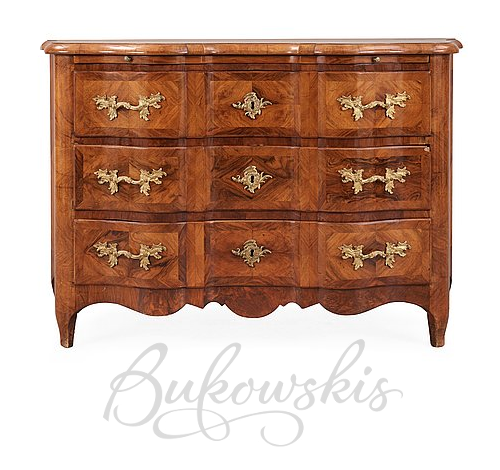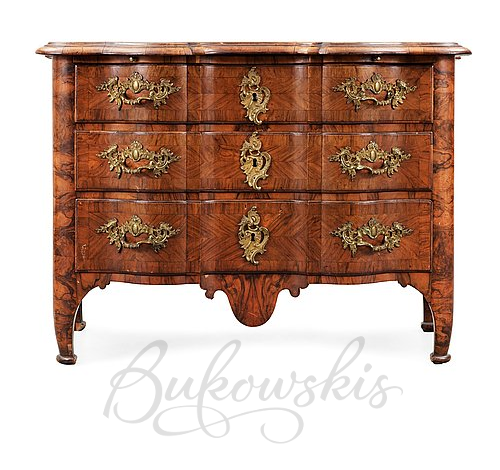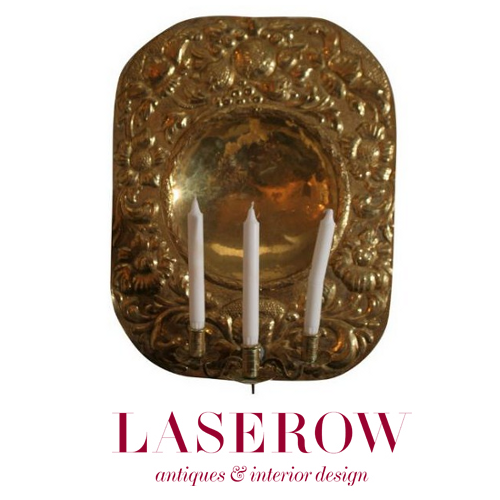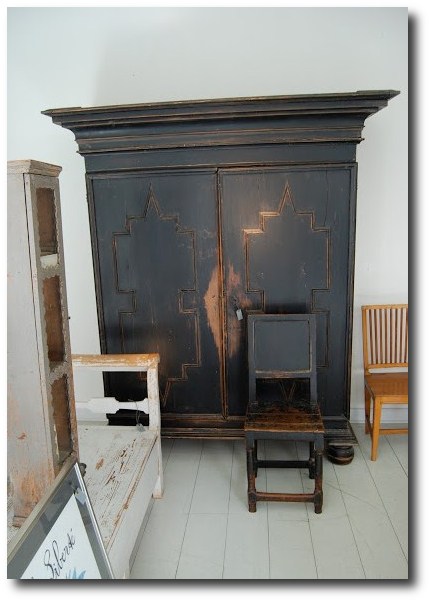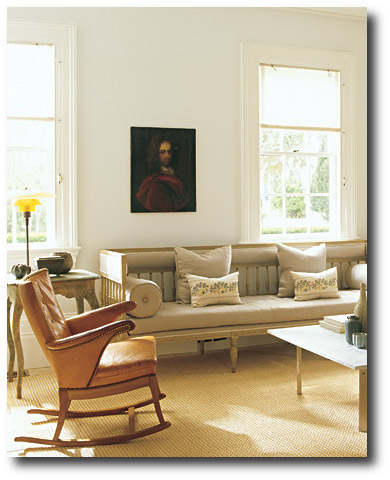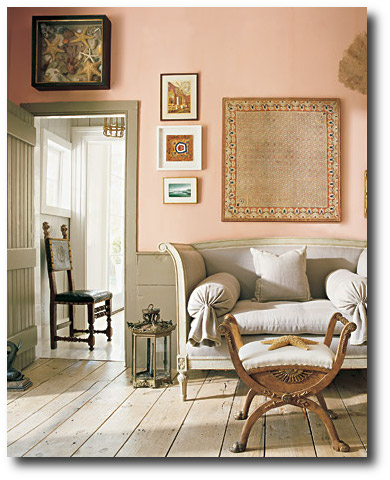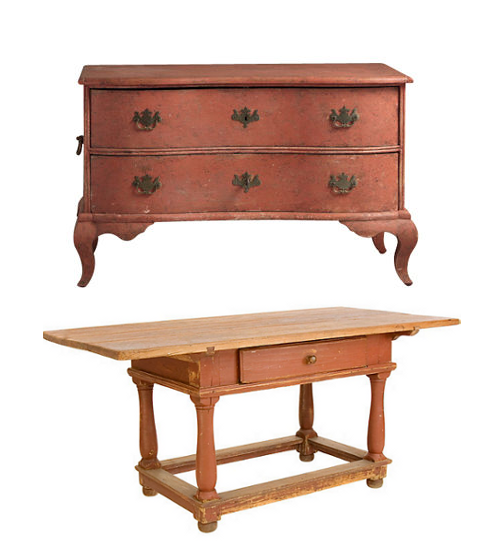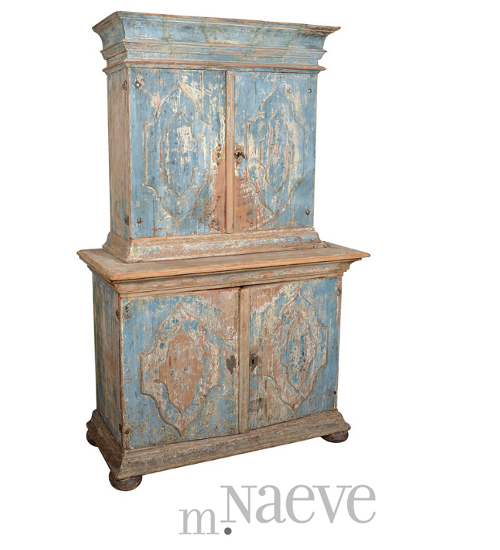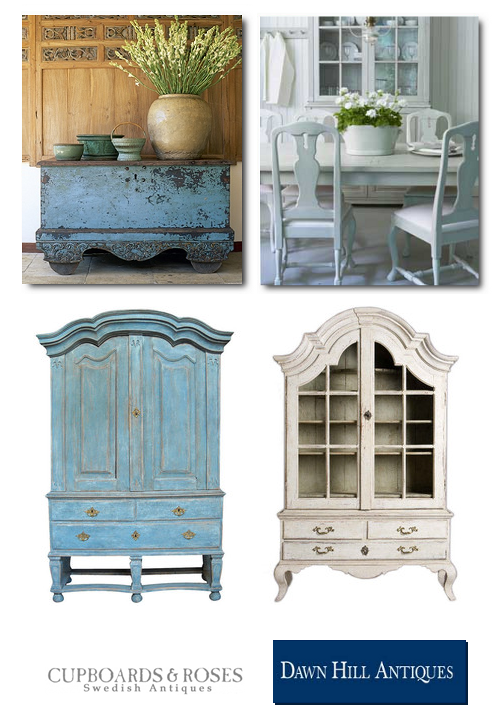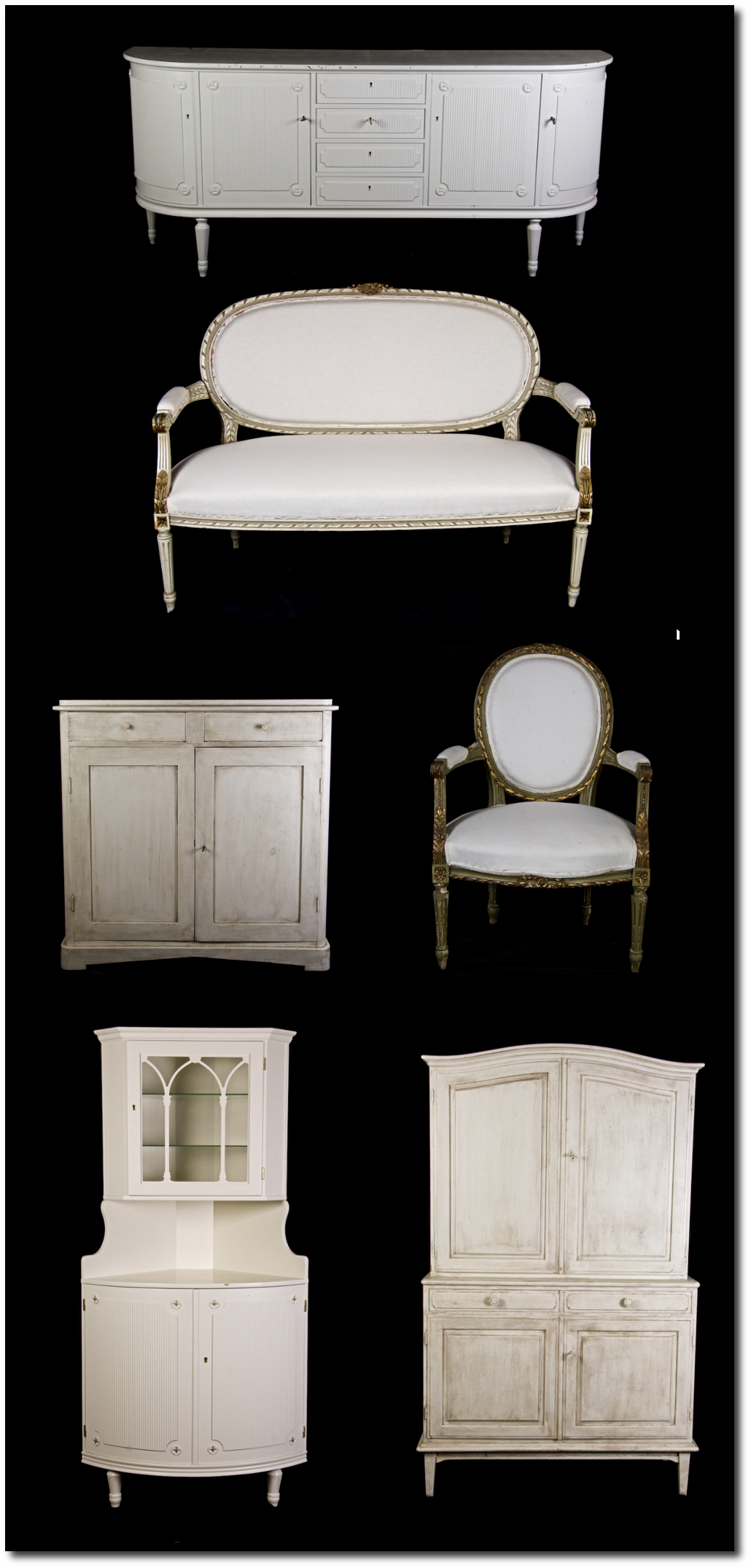Behind The Rundale Palace in Latvia
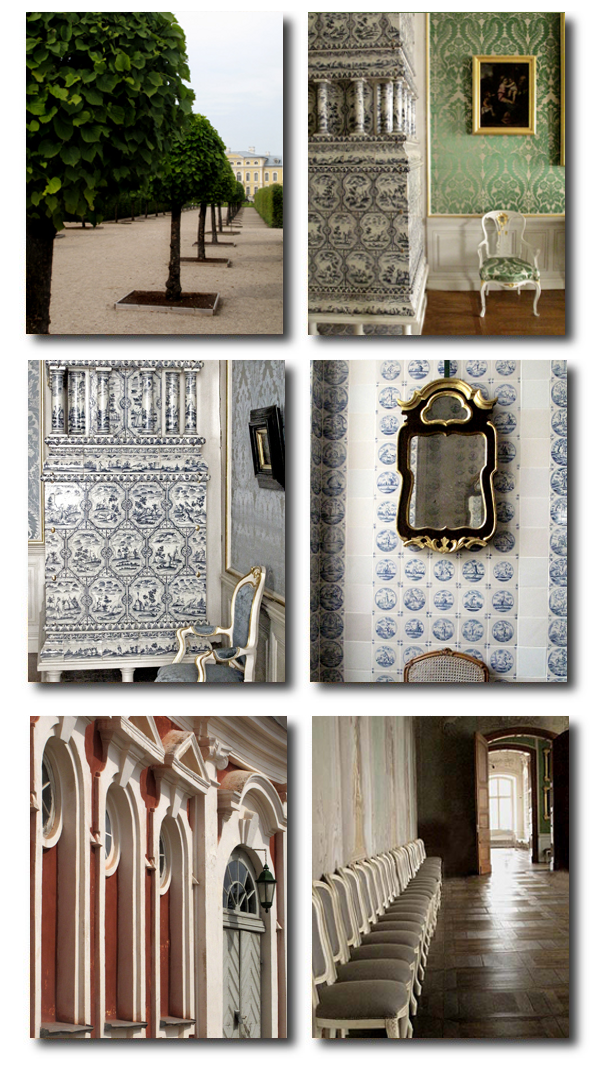
This week we’re visiting Rundale Palace in Latvia, newly restored to former glory. I can’t wait to go there.
This summer, New York-based photographer Christopher Flach discovered this world-heritage Latvian palace, Rundale. I had been aware of this baroque treasure, and knew it was undergoing major restoration. Chris was there just at the right moment.
Rundale, built between 1736 and 1740, is important because it paints a vivid portrait of the period from 1730 to around 1812. Rundale graphically embodies the world of an international coterie of eighteenth-century architects and craftsmen who traveled from one job-site to the next in Europe. These talents worked on palaces and museums for the Russian and Swedish and Latvian kings and czars and queens and empresses and nobles in the late eighteenth century.
Rundale Palace is one of the most outstanding monuments of Baroque and Rococo art in the Baltic region.
Read more at the thestylesaloniste.com
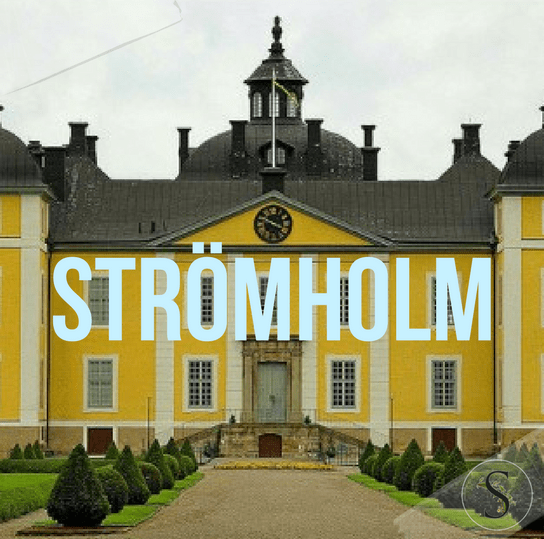
The Romantic Baroque Style: Part 1- Stromholm
If the Renaissance history is of interest to you, chances are you will love Baroque style. It is a design style isn’t that commonly seen in magazines, because the antiques are harder to find. If you are thinking about a design that is different and unique, this is certainly it! Baroque style originated in the 1600s in Italy before spreading throughout the rest of Europe. It originated in Rome, where the style was representative of the Catholic church, and was later adopted in the court of Louis XIV at Versailles. From there, the style spread to The Netherlands and Britain, and went on for almost two entire centuries, and became a less dramatic by the time the end of the 1700s.
Baroque didn’t go out of fashion suddenly. Rococo style was adopted, beginning in France in the late 1720s, especially for interiors, but the Baroque style continued to be used in architecture and interior design until the clean lines of Neoclassicism became the dominant style in the later 18th century.
Baroque style is a very ornamented style. Characteristics of this furniture are heavy, grand, theatrical, elaborate, and often rich in molding. The furniture is often very heavy detailed, did we say very heavy detailed? It is common to find baroque pieces which are intricately hand carved, such as turned legs and twisted columns. Louis XIV style is considered to the most identified example of Baroque style.
Baroque furniture is often larger in size. Canopy post beds are a good example of this. They were often grand with an excessive amount of carving. Cabinets, beds and chairs are all common pieces of furniture made in the Baroque style.
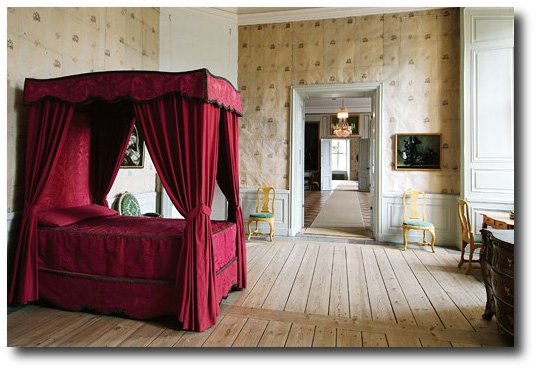

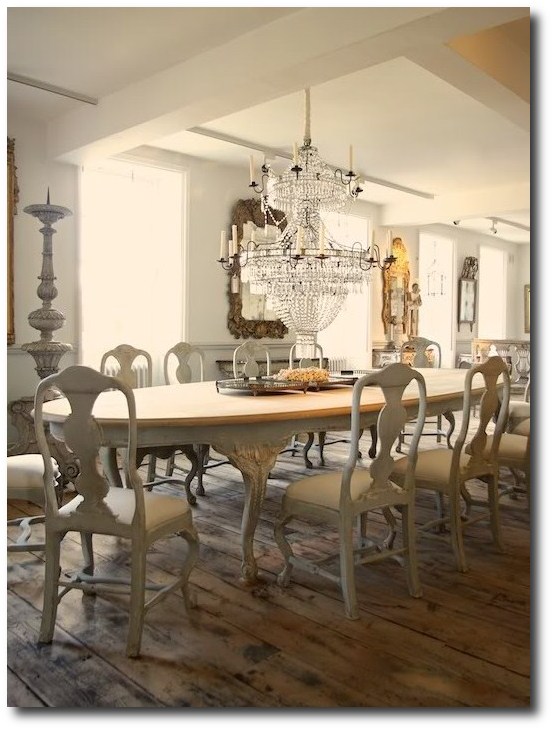
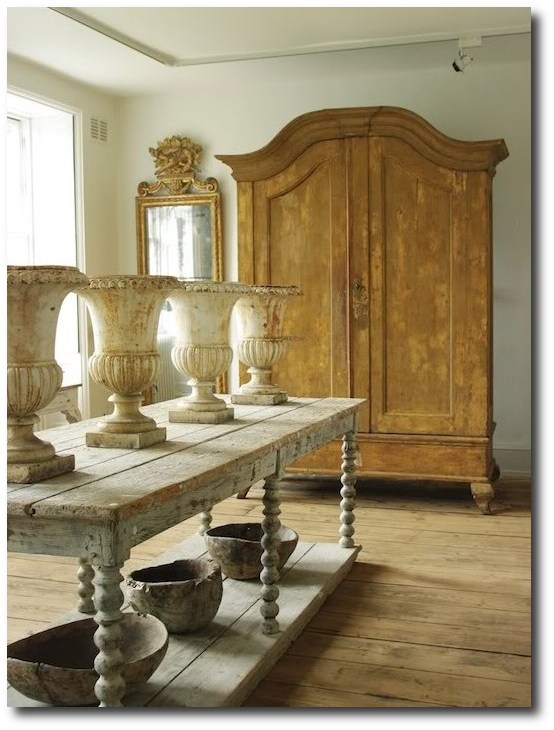
Sweden’s Strömholm’s yellow palace embraces the baroque style. This palace is a perfect mix between the baroque style with a Swedish flavor that is not at all Italian. Strömholm is located on the largest of three islands in the Kolbäckså river delta at Lake Mälaren. King Gustav Vasa had a farm on the property during the 1500’s. In 1560 the current castle was built between 1669 and 1681 for Queen Hedvig Eleonare. Strömsholm palace is one of the countries best examples of Baroque style. The Palace has royal interiors that are well preserved.
Additional Furniture To Admire
– A Swedish Baroque Table with Original Paintwork 1720s
-A mid 18th Century Swedish baroque drop-leaf table with its original blue paint
-A Swedish Baroque Centre Table circa 1750
-In Love With Swedish Baroque Mirrors
-Swedish Baroque drop-leaf table with original paint- Dienst + Dotter Antiques Picture 11
– Swedish Tray Topped Tea Table. Scraped to original blue paint. Beautifully shaped top with edge molding.Balustra shaped base on three legs.
A Swedish late Baroque 18th Century commode, attributed to J. H. Fürloh.
A Swedish late Baroque 18th Century Commode
Baroque Furniture From Augustus Brandt Antiques- Check out more pictures here
The Romantic Baroque Style: Part 2 King Gustav Vasa

Gustav I of Sweden, born under the name Gustav Vasa (12 May 1496– 29 September 1560), was known one of the most powerful kings in Swedish history.
Gustav was the son of a Swedish senator and of a noble family whom played a prominent part in aristocratic politics of 15th-century Scandinavia. He was raised in the courts of Sweden, and participated in the fighting against Denmark. In fact, the connections his family had with the royalty at the time, supplied Sweden with three regents.
Gustav fought in the army of Sten Sture the Younger against Christian II of Denmark in 1517–18. Sweden at that time was a part of a union consisting of the Nordic countries (Denmark, Norway, Sweden and Finland), but the union was a mess in many ways. The Danish king, Christian II tried to dismantle the union by using brute force. King Christian attacked Sweden in 1520, and the Swedish Regent was killed. It was then that Gustav found himself held hostage in Denmark, but later returned to Sweden when the King promised to show leniency towards those nobles who wanted to fight back.
The Danish king, Christian II then called a “friendly” meeting with all of the officials, but Gustav chose to stay home. Gustav found himself spared because of that decision. Christian II rounded up the nobles, and bishops and had them beheaded in the Great Square in Stockholm. Gustav’s father, brother-in-law and uncles were murdered, together with about 75 other men in a mass execution known as “the Blood-bath of Stockholm”.
The Vasa family lands were confiscated, and most of Gustav’s family were imprisoned. Instead of hiding or running, he rose to the occasion and started fighting back by engaging the people of Sweden to rise up for their country. He started sowing the seeds of rebellion against Christian II . The army of Denmark pursued him, but he managed to escape which many tales of these adventures are told today. He managed to receive backing from the Hanseatic League, which also wanted the Danish king weakened. This union allowed him to gather together a sizeable army, and in 1521 he was elected Regent of Sweden. This army then attacked the Danes in several engagements, and step by step managed to oust the Danish king.
Gustav pushed through to establish Sweden’s independence, and his leadership through this time may have been what was responsible for his election as king. In 1523, at the age of 27, Gustavus was elected King of Sweden. He set about reforming the country, using methods inspired by rulers like Henry VII and Henry VIII of England.
Gustav made Sweden an independent state and gave his country, for the first time in a century, nearly 40 years of stable and intelligent government. Gustav managed to unite Sweden, and also laid the foundation for Sweden’s professional army that was to make Sweden into a regional superpower in the 17th century. He managed to shape the foundation for modern Sweden.
Beyond those great achievements, he ranks among the heroes of Swedish history because of his struggle to turn Sweden from a Catholic country to a Renaissance state with a Protestant church. This was by far some of the hardest wars many countries had to battle.
In the documentary A Lamp In The Dark: Untold History of the Bible, goes into great detail the tremendous struggle individuals had to endure throughout the Middle Ages. I highly recommend watching this documentary on You tube to gain a better appreciation for the battle against the Catholic church.
The Catholic church was against having the bible in the hands of the common man, and threatened imprisonment and death to any persons who disobeyed their rule. Valiant warriors of the faith in England such as John Wycliffe, William Tyndale, Martin Luther, considered the cost for the sake of sharing the Gospel that salvation IS through Jesus ALONE, not through works, or anything else. They rejected the notion that the Catholic church set forth such as “sacrament” which individuals had to confess their sins to a priest instead of through prayer to our heavenly father to forgive our sins. (1 John 2:1-2)
The Catholic church positioned itself in control of individuals souls (salvation), and even went as far to ask money from people whose loved ones had died whom could be removed from “Purgatory” (Hell), which they taught every believer goes first, which was contrary to scripture. The Catholic church’s sheer dominance made them extremely wealthy because of the vast amount of people willing to paying money to remove their loved ones from the “Purgatory”, and this allowed the Catholic empire to throw their weight around in many countries. Believers also fought ideas brought by the Catholic church that the Pope was Yahweh himself on earth, stated by Pope Leo XIII, Pope Innocent III, and Pope Boniface VIII, which contradicted scripture. Once the common people were able to read the Bible, through the Protestant Reformation, they could hold the Catholic church accountable by the scriptures themselves.
Gustav fought hard to ensure the triumph of Lutheranism (named after Martin Luther), and the suppression of Roman Catholic customs. Gustav Vasa has been known as the founder of modern Sweden, and the “father of the nation”. Gustav looked up to Moses, whom he believed to have also liberated his people and established a sovereign state. Gustav I’s breaking with the Catholic Church is virtually simultaneous with Henry VIII doing the same in England; both kings acted following a similar pattern.
To understand the Baroque period, a person must take into account the religious and political tensions at the time. The Catholic church during this time was a very powerful entity and one of the biggest customers of of art. During the seventeenth century artists were being asked by the Catholic Church to create pieces of art which then could transend a message through which could be then understood by the uneducated common people.
The Catholic Church through this time was going through some major changes known as the period of ‘Counter – Reformation’ which began with institutional changes within the Catholic church as we discussed earlier. The clergy recognized that they could communicate through art by using the more theatrical ‘Baroque’ interpretation of religious themes. The Church buildings were designed and decorated in such a way which the Catholic church itself was trying to build it’s own empire kingdom apart from the Kingdom of God which we are told through the bible was the bodies of his people, not buildings and objects.
The mass amount of wealth church accumulated through using the very word of God in deceptive ways allowed them to buy thousands of paintings, thousands of statues, and buildings that were the best of the best through this time period. They owned the nicest buildings, and the most beautiful art across Europe, so it was no wonder why their style at the time became the design that many copied in architecture, interior design and so forth.
The upper classes ALSO loved to show off their wealth and saw this new style as rich, and unreachable for the common folks, so they embraced it, hoping to stand out. Wood carvings appeared lavish, and obviously was a style that many of the peasants could not afford. Baroque art and architecture was one approch they used to wave their money for the world to see.
From Italy, Baroque quickly spread to essentially every country in Europe. Each country incorporated its own customs and heritage with Baroque. Some were more extravagant and others more conservative with the design style. In Italy we saw tremendous detail in the furniture, where as in Sweden we saw more of a refinement with the style. The overblown carved details were softened, and mimimized. During the middle of the 16th century the Baroque Era gradually gave way to the Rococo, and this wave of style change hit each country at a different time in history.
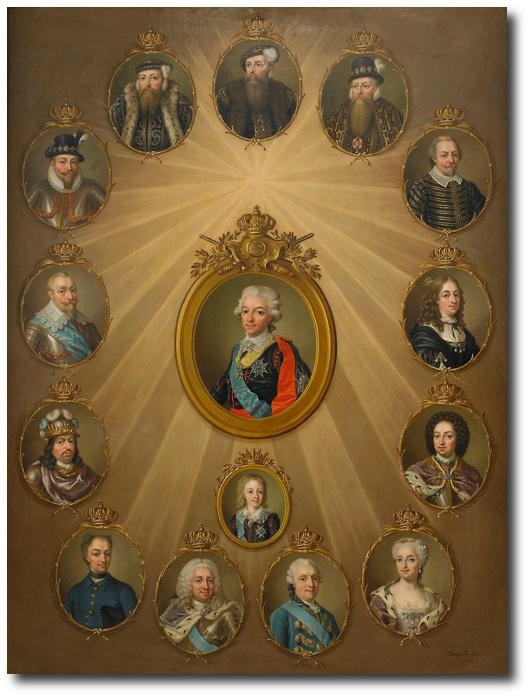
Gripsholm Castle belongs to the famous castles in Sweden.
This view shows how kings slept in the chamber of Charles IX.
Gripsholm Castle, Stockholm – Home of King Vasa And The Royal Family
Gripsholm interiors – Roof decorations National Museum Stockholm’s Flicker
Swedish Baroque Style Seen in The Linnaeus House -Elmar Eye’s photostream
National Museum Stockholm’s Flicker
Antique Original Painted Swedish Trunk, dated 1848 From Scandinavian Antiques
The reign of continued with Gustav’s sons Eric XIV, John III, John’s son Sigismund, and finally Gustav’s youngest son Charles IX.
Under Eric XIV the Reformation in Sweden proceeded on the same lines as during the reign of his Gustav Vasa, retaining all the old Catholic customs not considered contrary to Scripture.
After 1544, when the Council of Trent had formally been declared, the new teachings set forth by the Catholic church became obvious to that the Christian Bible, and the Catholic church were quite different. In fact, The Catholic Church created horrible laws at the Council of Trent that made it a death sentence for anyone who said the bread and wine used in Holy Communion were only symbolic. Sadly this entire history of the Catholic church has been covered up. Today the laws set forth in the Council of Trent still stand, and are upheld by the current Pope. The Popes during Vatican II Council have accepted the entire ratification of the entire council on this decree (Council of Trent, Session 13 Chapter VIII, Contradicting Hebrew 9:27-28; 10:11,12, 15)
King Gustav Vasa went on to publish a bible in Swedish for the people of his country. If he attended the “the Blood-bath of Stockholm” perhaps Sweden wouldn’t have Yahweh’s holy word, and perhaps never knew what Yeshua (Jesus) did on the cross for them. The Swedish Bible was published in 1540-41. The men behind the translation were Laurentius Andreae and the Petri brothers Olaus and Laurentius. Of them, Archbishop Laurentius is regarded as the main person. However, had the work not been commissioned by the Swedish King Gustav Vasa, who had in effect broken with the Pope in Rome in the 1520s, the work would not have been possible. The Bible follows the German version by Martin Luther from 1526 closely, not only in language, but in the fonts used and the typography as a whole. The Danish version, printed a few years earlier, also did this.
Charles Spada’s Normandy Home- See Part 1 and Part 2
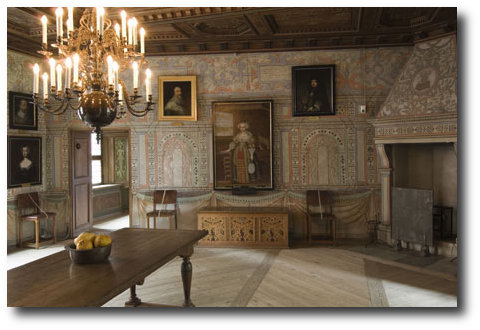
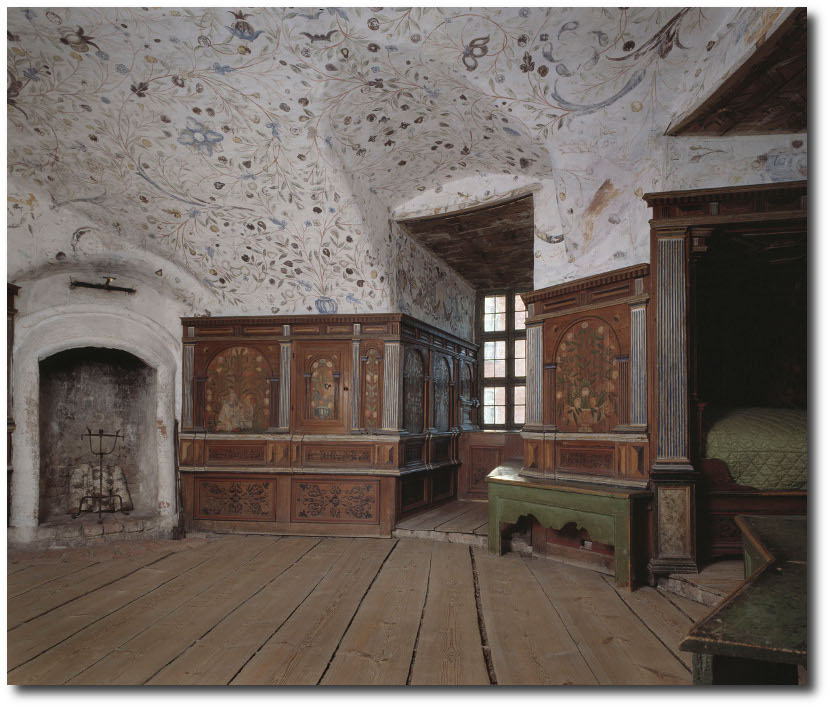
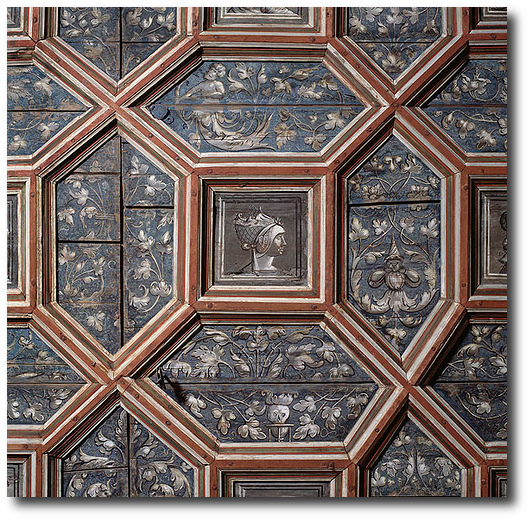
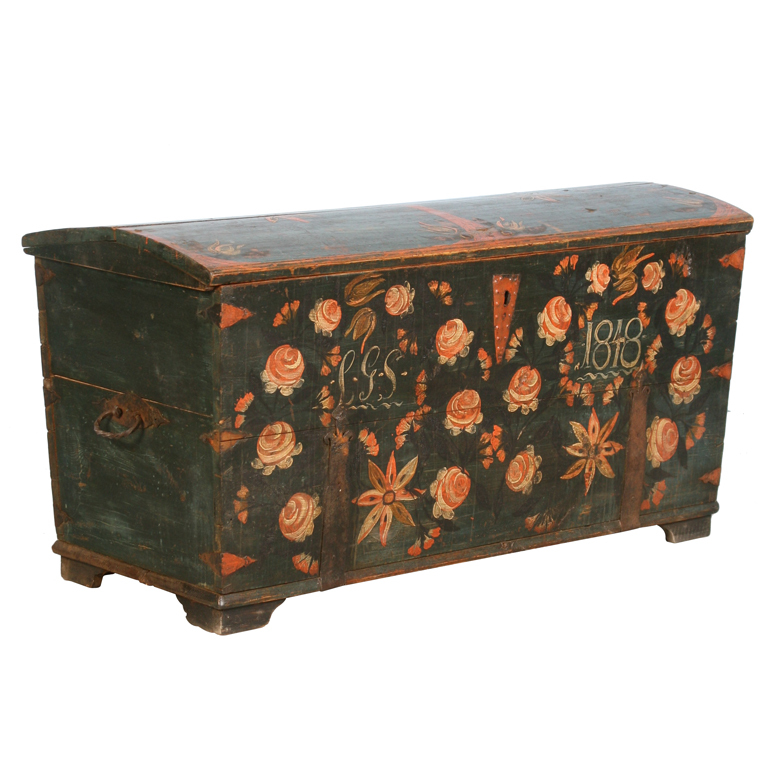
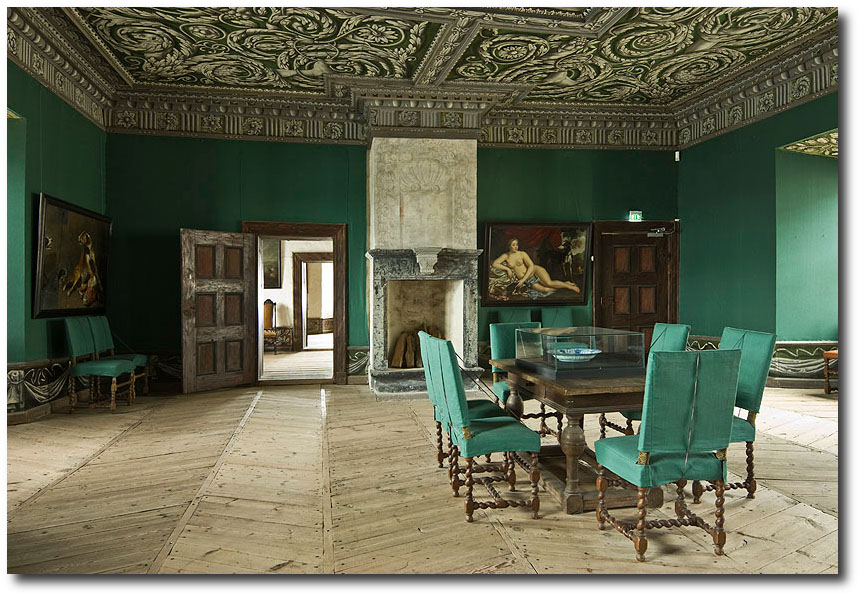
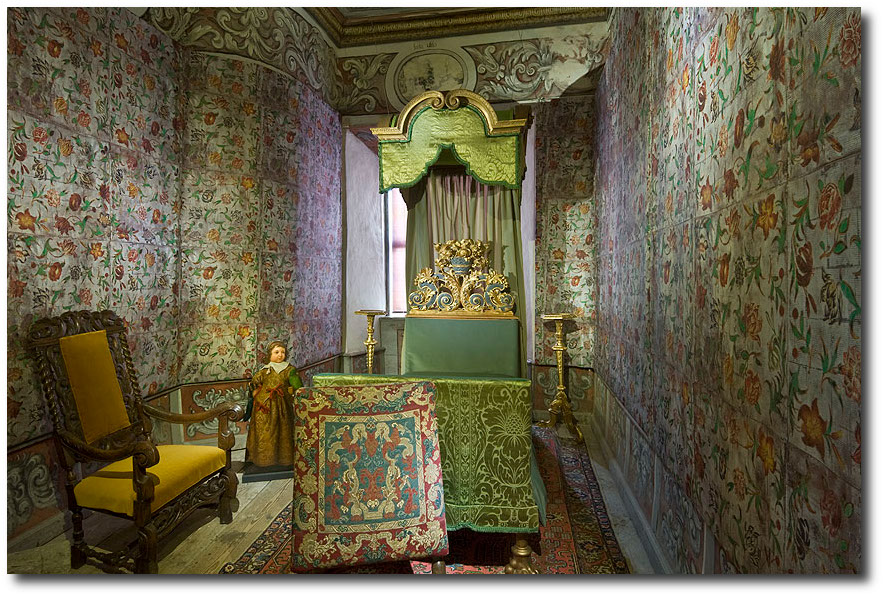
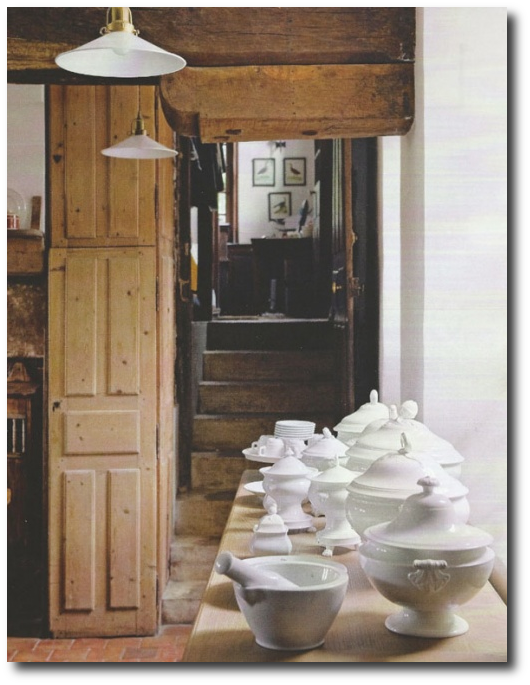
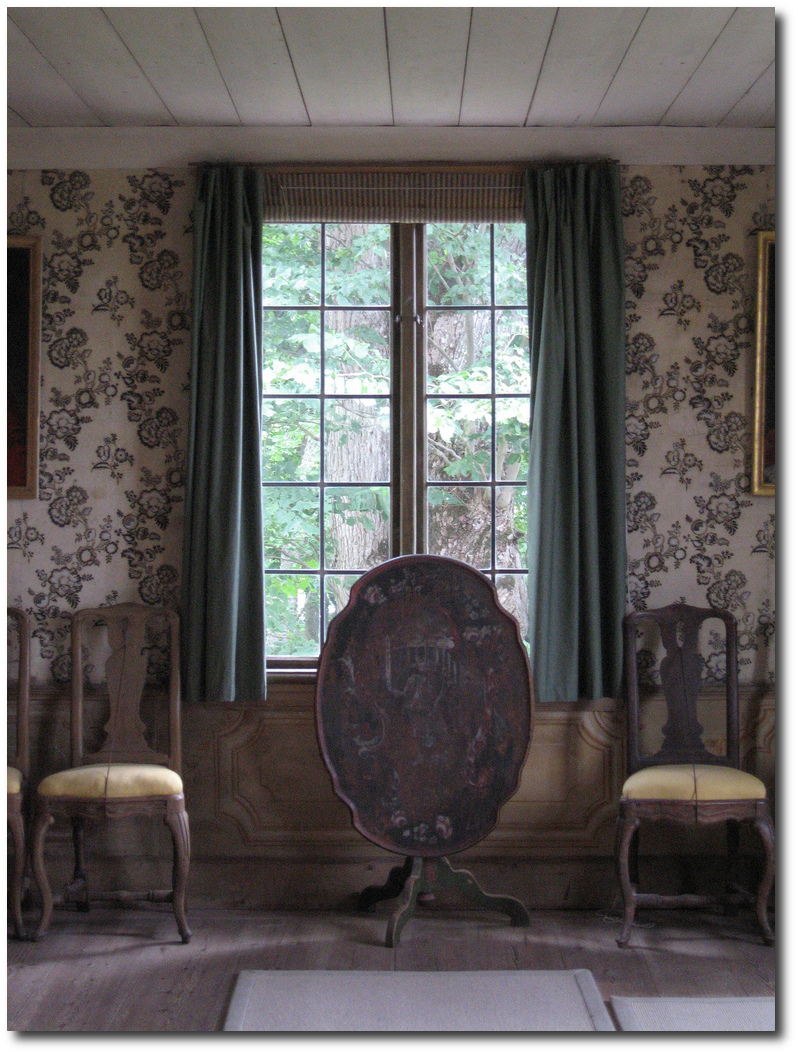
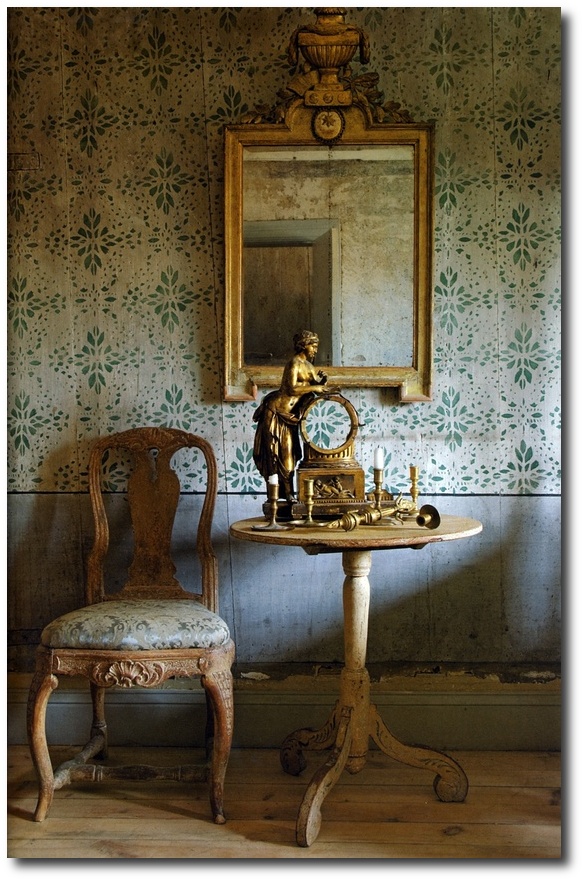
The Romantic Baroque Style: Part 3 Skokloster & Steninge Palace
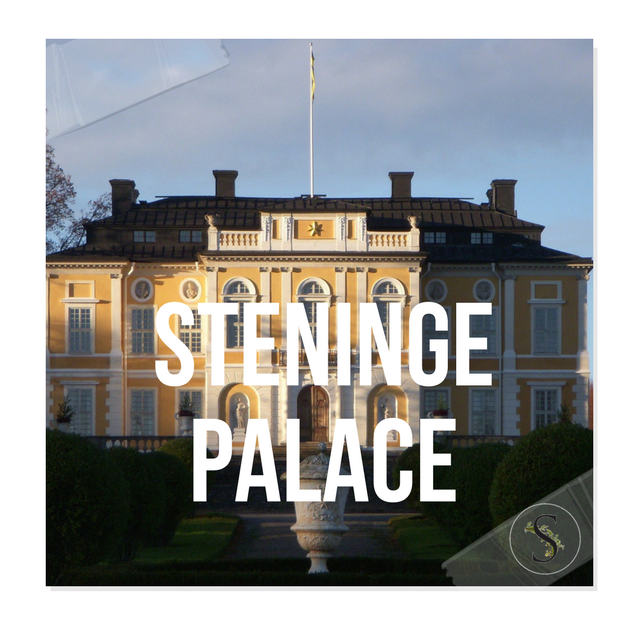
Swedish Skokloster Castle In the Baroque Style
King’s Hall in Skokloster Castle, Sweden
Steninge Palace, is called “Sweden’s most beautiful and perfect baroque building” Steninge, another palace located in Sweden stretches back to the 13th century. The palace has had countless owners; the Gyllenstierna (1649-1735) and von Fersen (1736-1839). In 1667, Carl Gyllenstierna 1649-1723, inherited the Steninge estate from his mother. His close relationship with the queen allowed him to develop the Steninge estate and the beautiful areas around Mälaren.
In 1680 the well-known architect Nicodemus Tessin the Younger was asked to design the Palace which were completed in 1705. Tessin was strongly inspired by the Baroque architectural style of Italian and French castles. This castle has only a few very small pictures of the interior, so sadly the interior isn’t photographed at large and available to the public. Nicodemus Tessin designed Steninge Palace with a blend of the Italian and French Baroque style with Swedish taste. It is said later that Tessin the Younger regarded Steninge Palace as his masterpiece.
Skokloster Castle is another castle in Sweden decorated in the Baroque styles, and is said to be one of the most important Baroque castles in Europe. Skokloster Castle was built as a residence between 1654 and 1676, when Sweden was a great power. Even to 17th century people, the imposing white building with its corner towers made a fairytale, ancient impression.
Steninge Palace Photographed By Keith Samuelson.com
See Information on Steninge Palace Here
Skokloster Castle From Adventures of A Far Traveler Blog
Skokloster Hallway – Photo Credit Richard Aufreiter
Large Swedish Baroque Brass Wall Sconce
Skokloster Castle
Two Door Black Swedish Baroque Cabinet 1770
Swedish Baroque Captain’s Arm Chair c. 1750
Swedish Baroque Cabinet and Chairs From romantiskahem.blog
18th Century, A Swedish Baroque Drop Leaf Table.
Drawers on each end of the center section. Split-leg support on each side.
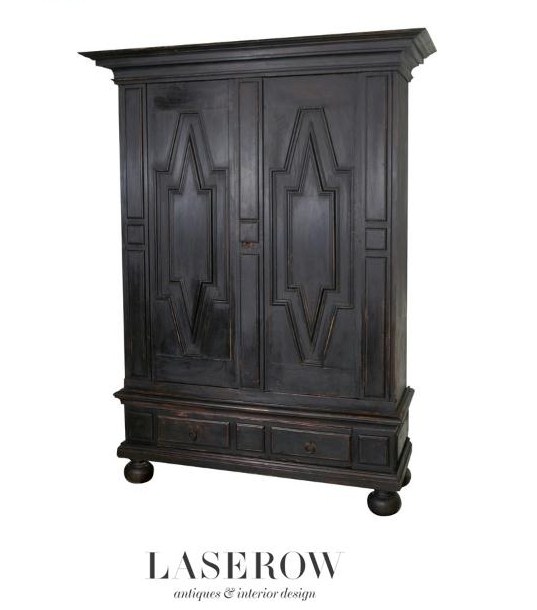
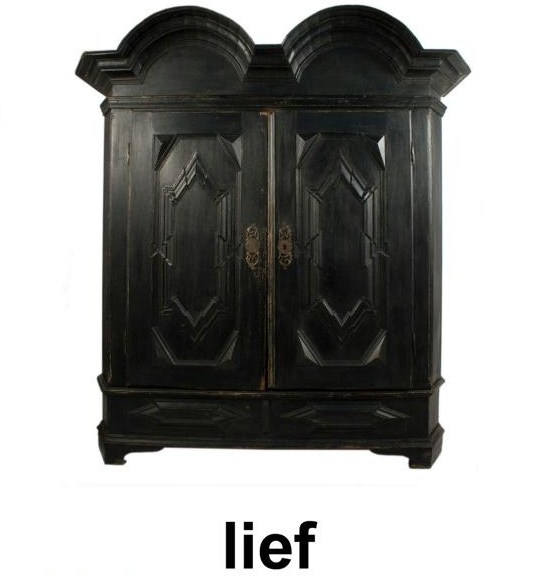
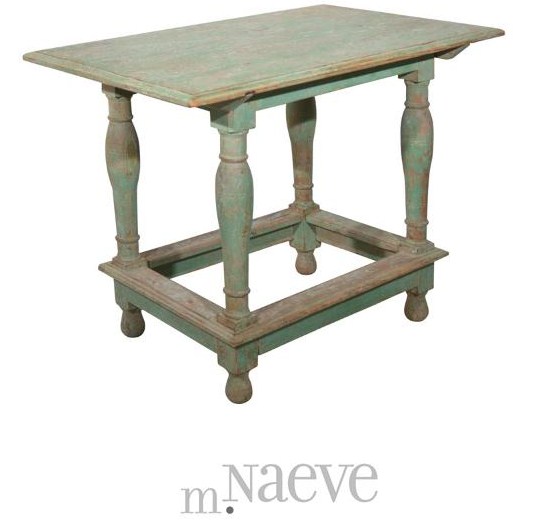
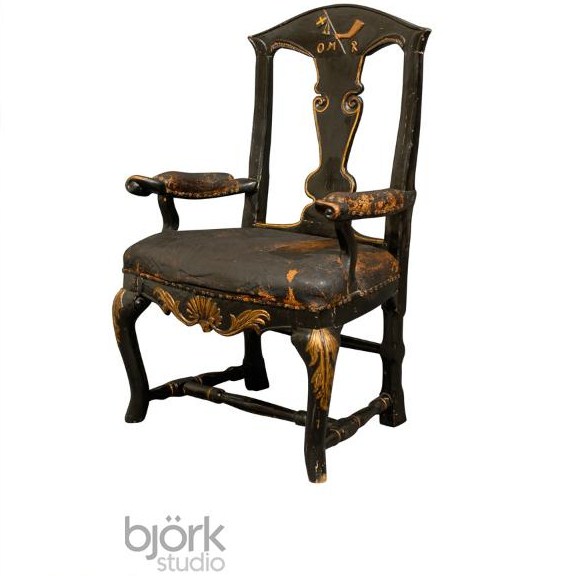
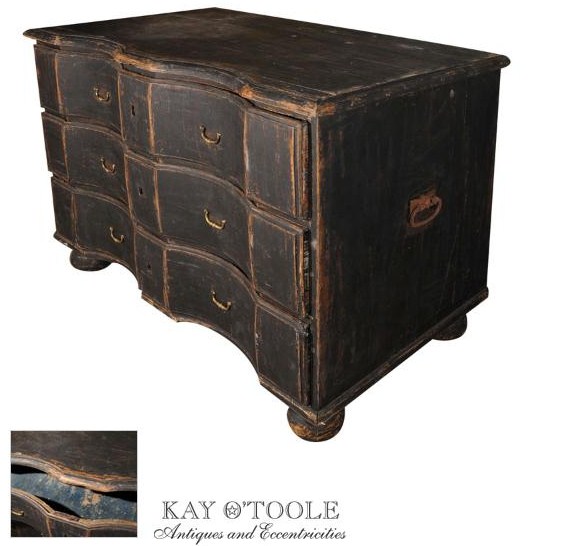
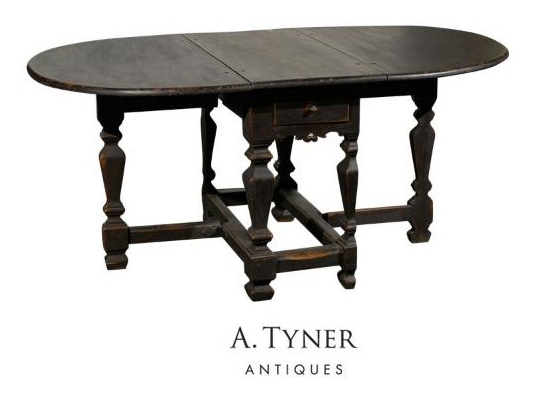
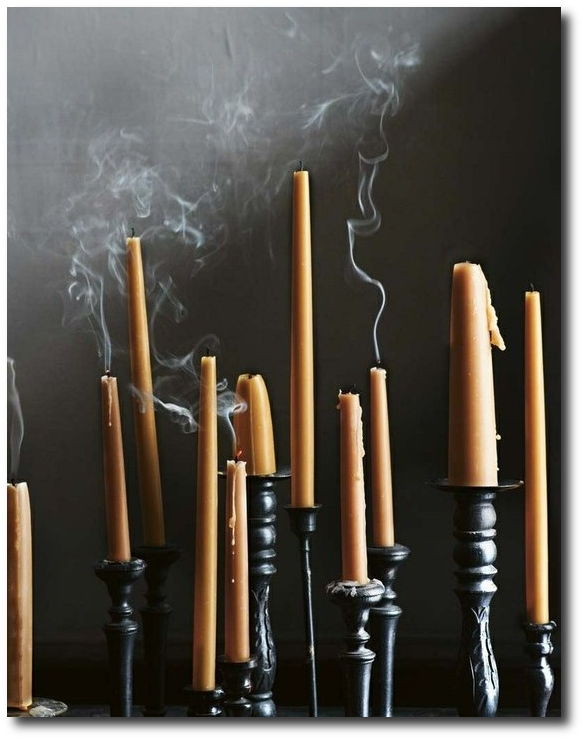
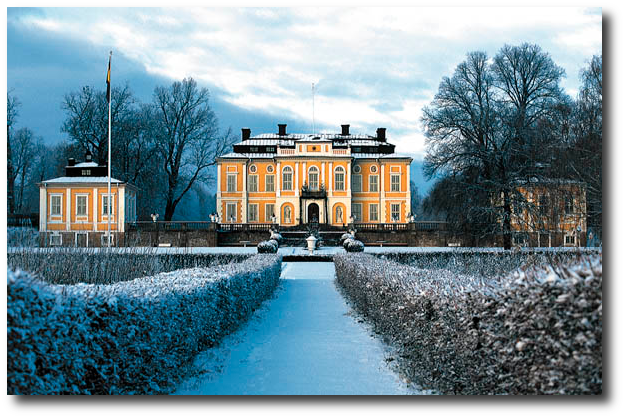
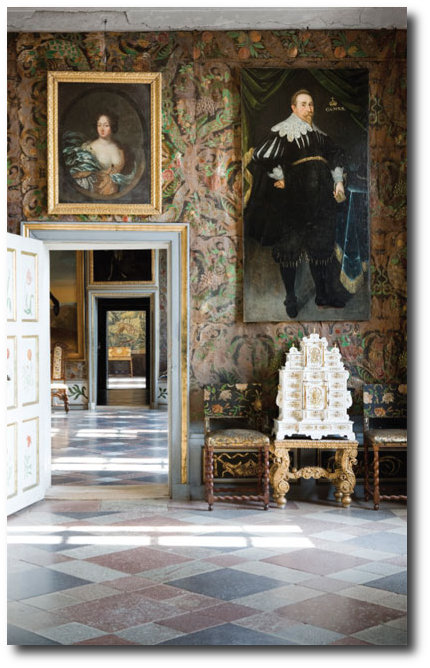
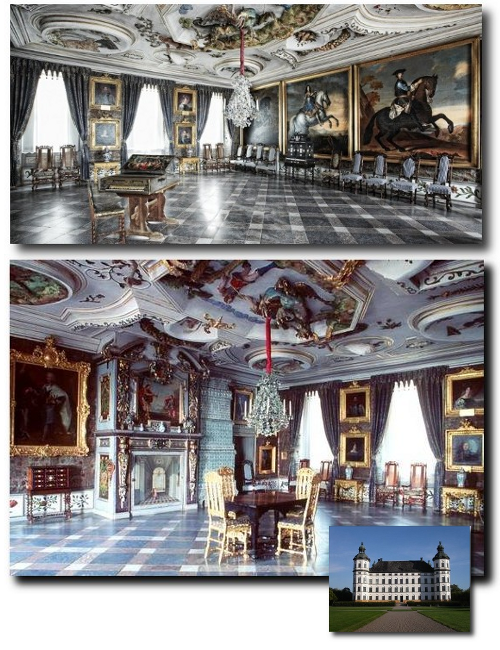
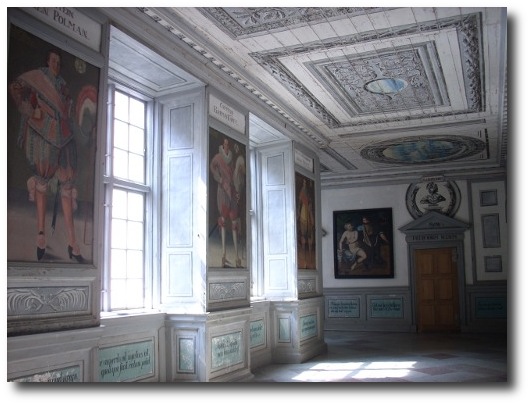
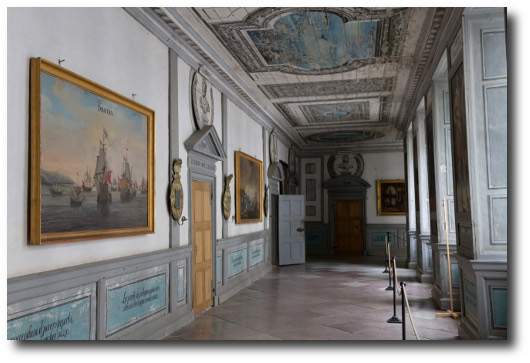
The Romantic Baroque Style: Part 4 – A Collectors Home
The Dienst’s Home
A Baroque Wing Chair Upholstered In Gray Linen, sits beside a Baroque Chest
In Sweden, the Middle Ages lasted for approximately 500 years, until Gustav I of Sweden seized power in 1523. Most all of the buildings were constructed out of timer, until the 12th century, where stone became the predominant building material for the construction of the churches. Lund Cathedral, and Husaby Church are excellent examples of this style. The Gothic style brought brick to Sweden as a new fashionable building material, and many of the cathedrals were fashioned out of brick, while others were made of limestone. 1,500 of Sweden’s 4,000 churches from the Middle Ages survive from this period. The 13th century city walls around Visby are some of the best-preserved medieval city walls in Europe, and in fact, the street layout of Stockholm’s Old City still can be seen designed with a medieval flavor.
Sweden rose to a great Power in the 17th century, the privileged class and government began to build again. The idea of the architect and designer was established and the profession developed. During this time works of Simon De la Vallée and Nicodemus Tessin the Elder became well known in Sweden. The work of Nicodemus Tessin the Younger moved the architectural development in Sweden during this time into High Baroque, such as Stockholm Palace.
As we discussed in Part 1, a notable example of the Baroque style in Sweden was seen in Strömholm. In part 2, we discussed King Gustav Vasa, whom was the ruling power at the time, and how the Catholic church dominated the design circles which influenced art across Europe and abroad. In Part 3, we discussed both Skokloster & Steninge Palace as striking examples of the Baroque style, which architect Nicodemus Tessin the Younger was responsible for. In part 4 and 5 we hope to inspire you to achieve this look in your own home looking at an example of a collector of Swedish antiques and what they did for their own home working with Baroque Swedish antiques in particular.
Jill Dienst’s owner of Dicost + Doner specializes in Scandinavian antiques from the 17th century to the mid-20th century. Jill Dienst’s passion for collecting for her own home over the years paved the way for her success as an antique dealer. Before opening up her own business, Jill Dienst spent decades at some of the finest institutions in the art, which allowed her to gain an appreciation for antiques and design world.
All images and information from Martha Stewart.
The centerpiece of the living room is a Gustavian sofa, which has been
upholstered in plain linen.
Mid-twentieth-century pieces by Danish designer Poul
Henningsen are mixed into the room
The simple, roll-up window shades are the same kind used in Swedish manor
houses, but these are made from a sheer fabric.
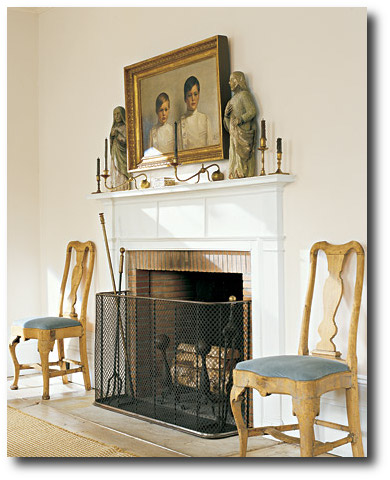 The living room walls and mantel were painted slightly different variations of
The living room walls and mantel were painted slightly different variations of
the same color.
The painting is a 1911 portrait of Swedish boys in school uniforms sit above the mantel.
The statues came from a rustic church in southern Sweden.
The candlesticks work beautifully with the gilt portrait of the Swedish boys
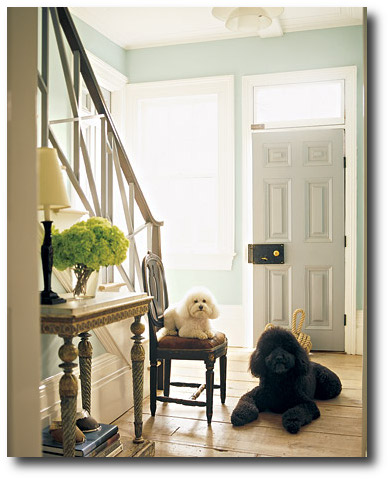 A black painted Gustavian chair and Gustavian giltwood console sit in the entryway
A black painted Gustavian chair and Gustavian giltwood console sit in the entryway
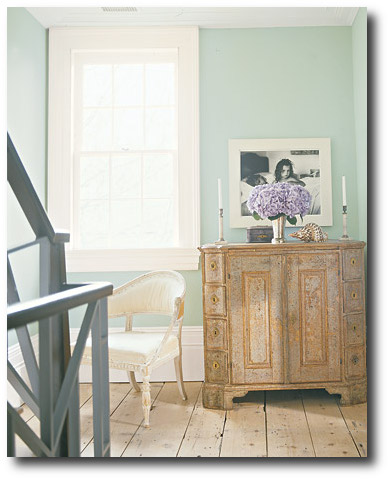
The second-floor landing features a large baroque cabinet from Sweden, which
retains its original paint.
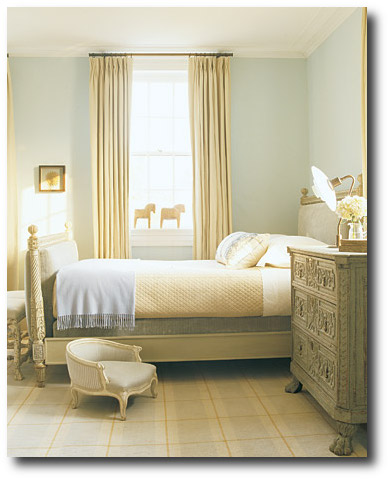
In their daughter’s room, a nineteenth-century bed has been reupholstered in a
heavy velvet.
French nineteenth-century chair by the bed. Dala horses, a traditional motif of Dalarna, Sweden sit in the window. The carved chest is German.
The Romantic Baroque Style: Part 5 Add Color
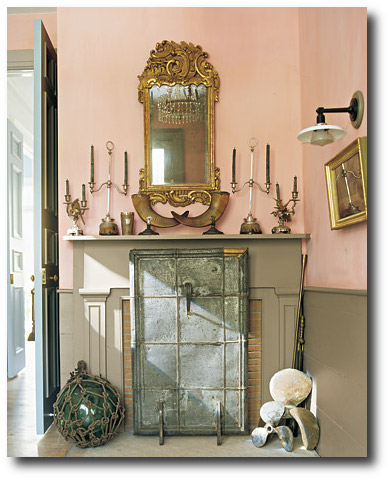 The Dienst’s home is an excellent example of a home decorated around the Baroque themes with a distinct Scandinavian design. The Baroque styles originate in Italy so most commonly we see examples of this style from that region, but rarely from the north or the south or any other region for that matter. In addition, the Dienst’s home is designed around some of the very best Swedish antiques making their home inspirational to all who are hoping to project this style for their own homes.
The Dienst’s home is an excellent example of a home decorated around the Baroque themes with a distinct Scandinavian design. The Baroque styles originate in Italy so most commonly we see examples of this style from that region, but rarely from the north or the south or any other region for that matter. In addition, the Dienst’s home is designed around some of the very best Swedish antiques making their home inspirational to all who are hoping to project this style for their own homes.
With so many modern variations of this style, there is no right or wrong when it comes to decorating and color. In fact, you may find that many top designers tend to embrace color to an extreme when working with the Gothic / Renaissance interiors. Many modern professional styled homes set around the Baroque period style tend to favor brighter colored interiors which do give the really primitive styled furniture a modern, updated look. Hot pinks, cobalt blues, reds and bright yellows mixed with the Baroque antiques give rooms a very premium designer feel.
You’ll also find that Baroque furniture is also painted in a plethora of colors. Painted furniture in hues of purples, blues, greens, reds, yellows, oranges can then be matched up with paint colors that work with the original paint on the antiques.
Fresco wall painting can also capture the picturesque look into a room. Stuccoing it can add that castle appeal that are seen in the ancient stone buildings. Many of the Swedish Baroque castles featured elaboate walls covered in wallpaper. Choose wallpaper with a colorful, detailed, motif pattern can still fit into the Baroque schemes.
While many people like to keep the windows rather minimal, study the designs to see what appeals to you best. Windows have been known to be one of the main characteristics of Baroque designs. Consider buying heavier draperies made from velvet, damask or silk which can be hung in a modern way. With this approch, your home can look updated using the right styles of fabrics without it looking like a museum.
Flooring, can truly make a break a room all on its own. Paint can transform a room without much cost, so I always suggest that any budget should be spent on flooring, and a few carefully chosen period antiques. Sweden has been known for its vast forests, so it made sense that flooring was made from wood. You simply cannot go wrong with pine flooring. Pine flooring also allows you to get away with vibrant paint shades on the wall, and almost any wallpaper pattern.
Baroque styled interiors rarely used rugs or carpeting. Rooms in the Baroque era usually used geometrical-patterned wood flooring. Besides parquet flooring, you can also use marble and stone floor tiles that were also used during that period. Make your own stone for the floor or walls using concrete molds. There are a variety of shapes and styles making period stone features inexpensive to produce at home.
Baroque furniture is typically large and heavy. With the modern bedrooms being much smaller in size, plan the furniture out before purchasing to make sure everything will fit to the bedroom. Consider investing your bedroom budget on a bed. A canopy bed with ornate carving and tall posts from which you can hang drapery would be an ideal choice.
Upholstered chairs are an easy way to match up patterns that match the drapery, bed canopy and the color of the wall. The bedding should match the theme of the drapery, wallpaper, upholstery, and the bed canopy. Ikat patterns have become tremendously popular in the last several years. There are so many different versions of this ethnic, bold weaving style that is likely one of the oldest patterns in existence. Get some examples from Kelli Ford & Kristen Fitzgibbons. Look for combinations of colors paired with white. Indigo and ocher and vibrant contrasting colors would be a great choice for a Baroque interior.
Period styled decor will also strengthen the overall design. Consider a combination of candlesticks and lamps. Choose a heavy crystal chandelier with both brass and glass to enhance the Baroque feeling. Add ceramic vases and bowls with floral oriental patterns to enhance a room that has color, or lack of color. Invest in large scale paintings or very heavy mirrors with ornate gilded frames.
In the two pink rooms, Dienst’s small parlor off the entry features an early-baroque spark screen. The mirror is Danish rococo, and the crystal chandelier it reflects is Gustavian. Brass propellers complete the look. Gray wainscoting and bare floors soften the vivid color of the walls, which are adorned with an array of small paintings, sea fans, and a framed collection of starfish. The Gustavian settee is upholstered in linen, the stool is from the mid-nineteenth century, and the side chair is baroque. A mid-twentieth-century Danish lamp stands on the floor by the settee.
Reclaimed Wood Dining Table From A Tyner Antiques
A.Pair of Swedish Baroque Commodes
B. A late-18th-century Baroque Swedish table with center drawer. Original red paint.
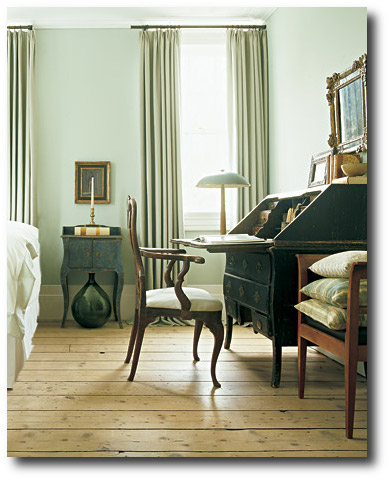 A black painted baroque Swedish desk sits in a guest bedroom.
A black painted baroque Swedish desk sits in a guest bedroom.
The small side cabinet is rococo, and
the lamp is Danish.
Swedish Baroque Table From the 18th Century
Beautiful Swedish Baroque cabinet in original blue paint
Landscapes on wood panel decorate the entry at Sandemar Manor in Sweden.
National Museum Stockholm’s Flicker
Picture Credit Home Beautiful Magazine , A. Tyner Antiques
Designer Miles Redd, Using Yellow In A Baroque Styled Room
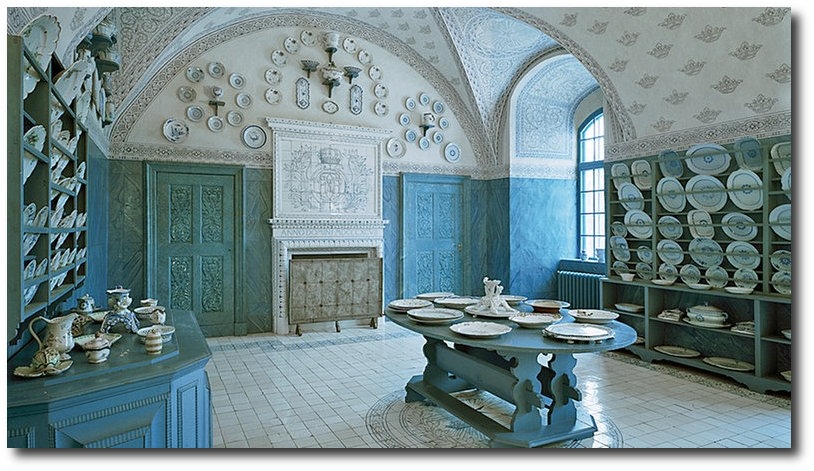
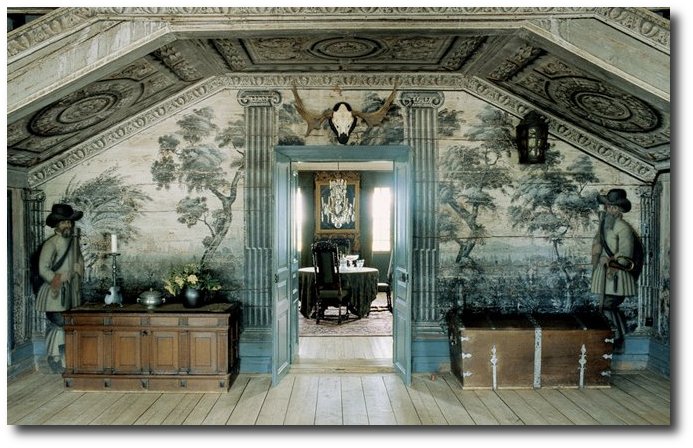

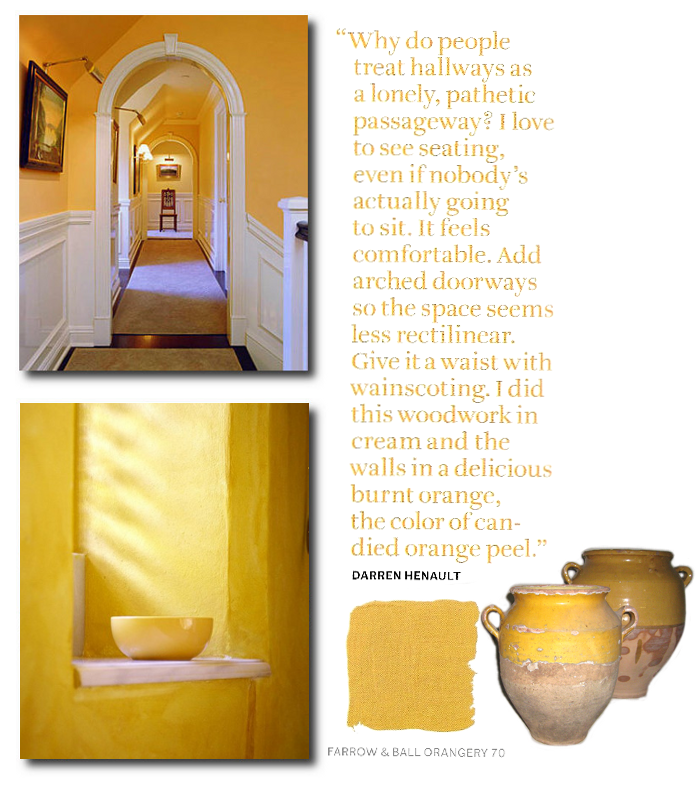
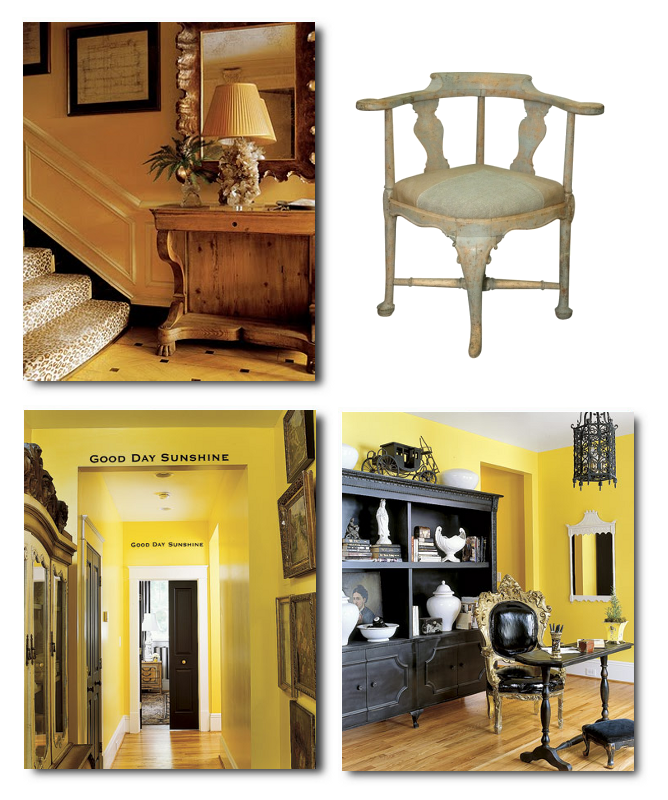
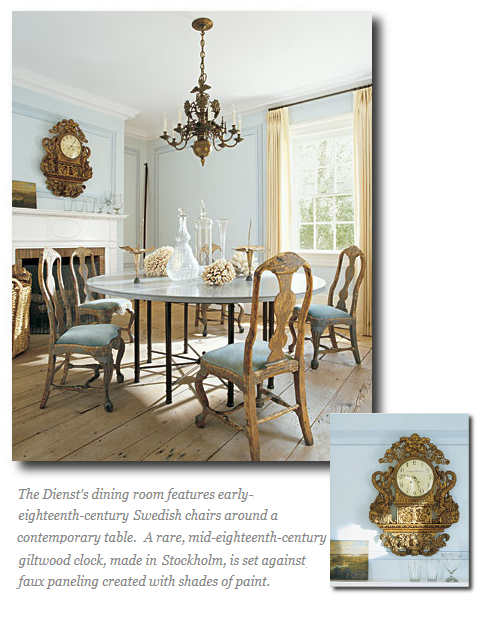
Jo lee of Swedish Interior Design talks about Swedish Antique Furniture
Jo Lee of Swedish Interior Design talks about Swedish Antique Furniture
Shabby chic reared its ugly head about 10 years ago as a cheap way of renovating furniture and giving your home a different feel. Based on the French and Swedish painted furniture and gustavian country pieces that had become distressed with age and use, it was the perfect way to find a cheap piece of furniture – lets say a chest of drawers- and smother it with white paint followed by a bout of sandpapering. You see this at fairs like ardingly where dealers try to offload their own ‘brown’ victorian furniture with a new coat of paint.
This in turn spawned the reproduction industry that now pervades the high street with cheap Chinese imports, some of which claim a ‘7 stage antiquing process-.
What a load of cobblers.
If you are happy with the rather clunky repro look (which really is now a look in itself) then go for it. You really see the difference not just in the paint finish but the poor quality of carvings especially on repro armoires.
But actually aging a piece convincing is a lot more complicated and time consuming than just hitting the sandpaper.
First of all you need to prepare the surface to take the paint smoothly and use the right kind of paint depending on the effect you are trying to create.
Acrylic can be good in some circumstances although it has a tendency to peel if the wood beneath it moves. Emulsion can be good for some topcoat finishing techniques if used sparingly – really depends what you are trying to achieve. Also be brave and create your own colours by mixing paints to make a statement in a particular room.
Even use several layers with slightly different colours to create texture.
Next the sand paper – be very careful to use the right grade and also composition as different types and weights of sandpaper give very different results – you may end up using several different types on a single piece.
Think careful where you distress so it looks natural – where would an old piece have got knocked about and where would it be marked from usage? Its actually fairly obvious when you think about.
Sometimes work with the grain and sometimes against it for effect and go slow – you can always do more but will have to repaint if you get too carried away. ‘Slowly slowly’ is the motto for this kind of work.
The key stage is then creating the patina of dirt that would accumulate on an old piece – this is what gives it a convincing feel and an aura of authenticity. I saw a cupboard recently done by someone which had been painted and sanded back rather badly.
And that’s just what it looked like because it didn’t have the sheen of ‘dirt’ that authentic pieces have. How do to do this well is somewhat of a trade secret and its down to getting the right colour mix for the ‘antiquing’ and applying it with subtlety. Again paying attention to where dirt and grime would naturally accumulate.
This is why repro stuff looks odd because you cant mass produce this feel convincingly as it takes time and artistry to do well.
Finally you might consider finding some old handles, escutcheons etc to give the piece a further lift – its amazing how this can elevate the feel of a piece quickly and make it your own
JO LEE is director of Swedish Interior Design
1900s Swedish Gustavian Grey Dining Table Extendable,1800s Antique Marble Top Gilt console table ,1800s Antique Swedish Pine Table In White- Swedish Interior Design
1800s Antique Swedish Gustavian Sideboard, 1800s Antique Swedish highly carved gustavian white side table, 1850 antique swedish handcarved gustavian gilt sofa, 1900s swedish carved pair of gustavian carver chairs with white upholstery, 1900s swedish classic gustavian white double door sideboard, 1900s swedish gustavian carved 2 seater, 1900s swedish gustavian cabinet, 1900s antique gustavian corner cabinet-Swedish Interior Design

